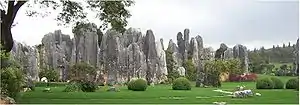Stone Forest

The Stone Forest or Shilin (Chinese: 石林; pinyin: Shílín) is a notable set of limestone formations about 500 km2 located in Shilin Yi Autonomous County, Yunnan Province, People's Republic of China, near Shilin approximately 90 km (56 mi) from the provincial capital Kunming.
The tall rocks seem to arise from the ground in a manner somewhat reminiscent of stalagmites, or with many looking like petrified trees, thereby creating the illusion of a forest made of stone. Since 2007, two parts of the site, the Naigu Stone Forest (乃古石林) and Suogeyi Village (所各邑村), have been UNESCO World Heritage Sites as part of the South China Karst.[1] The site is classified as a AAAAA-class tourist site.[2]
Features

Shilin National Scenic Area (昆明市石林风景区) covers an area of 400 km2 (150 sq mi) and is divided into seven scenic areas as follows:
- Greater & Lesser Stone Forests (大小石林) - also known as the Lizijing Stone Forest (李子菁石林)
- Naigu Stone Forest (乃古石林)
- Zhiyun Cave (芝云洞)
- Lake Chang (长湖 literally Long Lake)
- Lake Yue (月湖 literally Moon Lake)
- Dadieshui Waterfall (大叠水瀑布)
- Qifeng Cave (奇峰洞)
These formations, caused by the weathering of limestone, are believed to be over 270 million years old[3] and are a tourist attraction for both overseas and domestic tourists, with bus tours bringing tourists from Kunming. There are also a number of hotels in the area.
Geology
The Stone Forest area was a shallow sea some 270 million years ago. Extensive deposits of sandstone overlain by limestone accumulated in this basin during the Permian period of geologic time. Uplift of this region occurred subsequent to deposition. Later, exposure to wind and running water shaped these limestone pillars. These formations extend as far as the eye can see, looking like a vast forest of stone, hence the name "The Stone Forest".[4] The Major and Minor Stone Forests are developed in the nearly pure limestone of the Permian Makou Formation. The Naigu Stone Forest, 9 km northeast of the Major Stone Forest, is developed in dolomite and dolomitic limestone of the Permian Qixia Formation. Both formations are of Lower Permian age. They aggregate 505 m in thickness and consist of shallow water (platform) massive limestone and dolomite, bio-clastic limestone, calcarenite and calcilutite. The Maokou Formation at Stone Forest appears to have been heavily altered diagenetically, and macroscopic fossil remains are seldom seen. Under the microscope, single whole or fractured fusulinid foraminifera are seen, commonly in biomicrite, biopelmicrite to biopelmicrosparite limestones. At least one zone of chert nodules occurs in the limestone. Unlike in the dolomitic Qixia Formation, dolomite in the Maokou Formation seldom ranges above 3%.
The strata are part of a gentle (2-6 degree) westward dipping monocline. Conjugate shear joints (NE-SW and NE-SE) are well developed and these fractures provided the main passageways for surface and underground water in the pre-karst development stage. The distribution, density and orientation of the fractures controlled the depth, size and orientation of the karst topography. Sandstones and shales of the Liangshan Formation that lies below the carbonate rock formations serve as a permeability barrier and force the local groundwater to flow from west to east.
Flora
The Shilin Karst area has the following types of forests and plant communities.[5]
- Evergreen broad-leaved forest: Cyclobanopsis glancoides, Cyclobalanopsis delavayi, and Castanopsis delavayi
- Sclerophyllous evergreen broad-leaved forests: Quercus cocciferoides and Quercus franchetii
- Deciduous broad-leaved and subtropical needle-leaved forests: Pinus yunnanensis
- Lake vegetation: Ottelia acuminata
Other plant species
- Sino-Himalayan subregion species: Colquhounia, Corallodiscus, Docynia, Lysiontus, Physospermopsis, Prinsepia, Sinocrassula, Siphonostegia
- Sino-Japan forest subrealm species: Akebia, Conandron, Sinomenium, Platycladus
- East Asian Realm species: Ainsliaea, Bletilla, Codonopsis, Dendrobenthamia, Eriobotrya, Leptodermis, Lycoris, Ophiopogon, Patrinia, Reineckea
Culture
According to legend, the forest is the birthplace of Ashima (阿诗玛), a beautiful girl of the Yi people. After falling in love she was forbidden to marry her chosen suitor and instead turned into a stone in the forest that still bears her name.[6] Each year on the 24th day of the sixth lunar month, many Yi people celebrate the Torch Festival (火把节 Huǒbă Jié), which features folk dances and wrestling competitions.
See also
References
- "Twenty-two new sites inscribed on UNESCO's World Heritage List, and one deleted during Committee meeting in Christchurch". UNESCO World Heritage Convention. June 29, 2007. Retrieved February 17, 2011.
- Chris Ryan, Gu Huimin and Fang Meng (2009). "Destination planning in China". In Chris Ryan and Gu Huimin (ed.). Tourism in China: Destination, Cultures and Communities (1 ed.). pp. 11–37. ISBN 9780203886366.
- Stone Forest from travelchinayunnan.com Archived 2007-11-22 at the Wayback Machine
- "Geoscience Resources".
- UNESCO: South China Karst
- "The legend of Ashima (阿诗玛的传说)" (in Chinese). Yunnan Provincial Government Website. April 26, 2005. Archived from the original on April 12, 2006. Retrieved February 17, 2011.
Further reading
- A virtual field trip to the stone forest, Kunming, Yunnan Province, China.
- Zhang, S. (1997). "Stone forest in China and pinnacle karst in Madagascar". In: Song, L. et al. (eds.) Stone Forest: a Treasure of Natural Heritage. China Environmental Science Press (see pp. 78–80), Beijing.
- How do stone forests get their spikes?